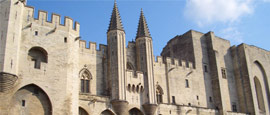Avignon History
Avignon’s history is one of acrimony. Fought over, occupied and the centre of papal and political intrigue, this city only became part of France in the late 18th century.
Although civilisation here dates back as late as 4,000 BC, it was the arrival of the Romans, followed by Christianity, that turned Avignon into one of Europe’s biggest and most important settlements. Its key position on the Rhone meant it was squabbled over by Gothic, Saracen and Frankish tribes throughout the early Middle Ages, before the papacy arrived in 1309.
Chosen by Pope Clement V as his preferred seat instead of Rome, popes stayed in the city until 1377, when a schism in the church saw church leaders installed in both cities. The Papal Palace, still Avignon’s most remarkable building and first built as a fortification in 1252, played home to the popes. From here they administered power throughout Christendom, also ensuring the surrounding region became renowned for its wine, especially around the area of Chateauneuf du Pape.
Although Avignon remained a papal enclave, the city inevitably lost some of its lustre after the church returned to Rome in the early 15th century. After endless invasions and sieges, Avignon eventually became part of France in 1791; two years after the country’s revolution began. The city grew beyond its walls over the following one hundred years, its population booming during the inter war period, before being occupied by the Nazis during WWII.
The post–war years saw the city gain cultural significance through its annual theatre festival, founded in 1947, with the historic centre earning UNESCO world heritage status in 1995. Crowned Europe’s City of Culture in 2000, Avignon has become a hub for contemporary art, thanks in large part to a €100 million gift of artworks by gallery owner Yvon Lambert.
Did you know?
• Avignon holds two arts festivals each year. The official Festival d'Avignon (‘Festival In’) as well as the smaller ‘Festival Off’, which features unknown works.
• The Pont d’Avignon, also known as Pont St Benezet, dates back to 1177, part of it still standing today.
• The original Avignon Roman Forum stood where Place de l'Horloge does today.
Do you have any Feedback about this page?
© 2025 Columbus Travel Media Ltd. All rights reserved. No part of this site may be reproduced without our written permission, click here for information on Columbus Content Solutions.




 You know where
You know where